A brick oven-barbecue for cooking, built in compliance with the technology, will last a long time. There are options with advanced functions, it is installed in a common complex with a tandoor, barbecue hearth, Russian stove, smokehouse, fireplace. A brick barbecue oven in combination with a recreation area will become a significant detail in the landscape design of a garden plot in the country.
- Safety requirements
- Features of placing a barbecue
- Types of barbecues and the specifics of placement
- Installation principles
- Advantages and disadvantages of a brick barbecue
- Difference between barbecue and barbecue
- BBQ design
- Design and drawing
- Brick BBQ Materials and Tools
- Number of bricks for building a barbecue
- Foundation
- Choosing a brand of cement
- Concrete preparation and pouring
- Laying a simple barbecue oven with a firebox
- Barbecue rules
Safety requirements
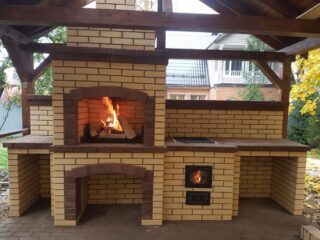
The barbecue is a fire hazardous equipment.
Rules to follow during installation:
- the surface in the working area is concreted, covered with asphalt with a layer of at least 100 mm;
- Descending and curly flowers, plants in the cooking area are not allowed;
- the grass in the nearby area is covered with bricks and tiles.
Flammable materials and containers with flammable liquids must not be stored at a distance of 2 m around the perimeter of the furnace. Flying sparks contribute to a fire.
Features of placing a barbecue
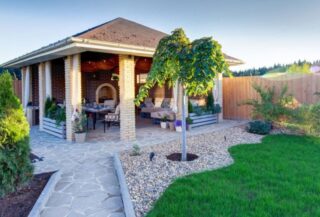
The area with a brick barbecue is protected from wind gusts. To do this, use the natural relief, neighboring buildings. It is better to build a wall from the side of the prevailing winds with a height of 2 m. If the hearth is on the border with an adjacent summer cottage, you need to discuss the fact of location with a neighbor.
Provides a convenient passage to the cooking and rest area. They make wide paths with a non-slip surface, provide good lighting in the dark. Often, a barbecue is set up near the bathhouse in order to combine the steam procedure with cooking kebabs.
Types of barbecues and the specifics of placement
According to the location of the stove, there are free-standing ones, a gazebo with a barbecue is combined with a residential building or other building. The pavilion and the house can have a common roof, base. The barbecue room is made small or provides for a large area where mass celebrations are held.
Barbecues are placed indoors:
- open for summer use;
- closed with glazed openings, used all year round.
Brick hearths are placed in the garden, on the veranda, on the terrace of the house. Separate stoves are made with a Gothic roof, in the form of a tower, stylized as a Russian stove. If they do not make a gazebo, then they put a canopy or a simple visor to protect it from precipitation.
Installation principles
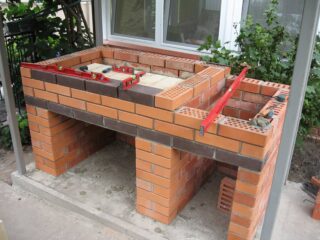
A brick brazier made of bricks has a significant weight, therefore, it requires a strong slab of concrete that can withstand the load.
Installation tips:
- if the stove is placed on a wooden base, finish with materials with a low degree of ignition or cover the floor with iron sheets;
- in closed rooms, you need to build an effective smoke exhaust scheme, make a stationary chimney;
- You can lay out the masonry of the stove with your own hands, but you need to follow the guide and follow the ordering drawings.
For a hearth in a gazebo, it is better to build one foundation while erecting it so that the structures do not move relative to each other.If the base is attached to the existing one, the foundations are not tied.
Advantages and disadvantages of a brick barbecue
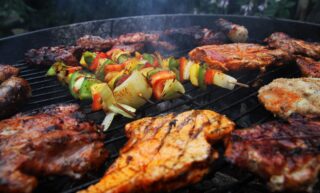
The stationary folded hearth furnace belongs to durable structures. The design is aesthetically pleasing and there are many decoration options.
Other pluses of a brick barbecue hearth:
- the special taste of the dishes, imparted by the smoke;
- a variety of dishes - the ability to bake meat, fish, cook vegetables, barbecue, and other products;
- inexpensive fuel.
The downside is the complexity of construction. For masonry, a significant amount of brick is needed, which is not cheap.
Difference between barbecue and barbecue
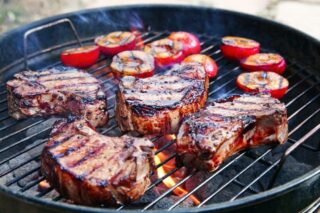
The brazier is a rectangular heat-resistant container where a fire is made and skewers are placed on the walls. High sides prevent sparks from scattering in the wind. Barbecues are made in the form of a round metal brazier, where food is placed on a wire rack. It is possible to install skewers in a circle.
In a barbecue, the heat is distributed evenly throughout the brazier, and in a barbecue, the temperature is higher in the central area. In the middle of the grill, large pieces of meat are placed so that it is well fried, which cannot be done on a skewer in the grill.
BBQ design
Modern stoves have two or more combustion chambers, which makes the brick hearth multifunctional. A smokehouse, a hob, a cauldron are built into the structure, so many dishes can be cooked on one tab of fuel.
The barbecue oven has a grate, which is lowered 5-7 cm below the edges of the brazier. Small holes are drilled in the pallet, which creates the necessary draft. Smoke accumulates behind high walls, such a smoke collector contributes to the creation of an original aroma in the finished product.
Design and drawing
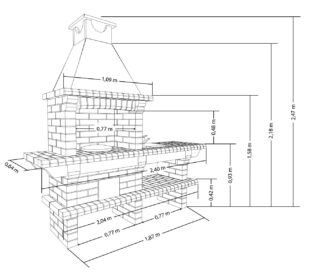
Projects of barbecues made of bricks with accurate calculations are made taking into account standard recommendations:
- the depth of the pallet is made 15 - 17 cm, this parameter is enough for a layer of coals, and the products will be at the required height;
- the brazier is placed at a height of 1.0 m from the base of the floor;
- the width of the brazier in the plan is 1.0 m, the distance from the front to the rear wall is at least 50 cm.
The dimensions of the heat-resistant container are chosen so that it is convenient to place food and skewers.
Brick BBQ Materials and Tools
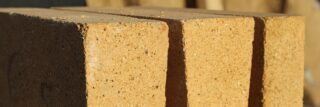
From tools you will need a trowel, shovels, a container for mortar, a hammer. Prepare a tape measure, plumb line, level. To beat off a brick, you need a pickaxe, or it is cut with a grinder. You need a wooden or metal ordering with divisions of the arrangement of bricks in a row. For marking, take a cord and pegs.
Prepare materials:
- brick;
- cement M 350 or M 400, medium-sized crushed stone, sand;
- waterproofing;
- clay;
- metal for the brazier, door for milking the furnace chamber.
Refractory bricks are used, the internal firebox must be laid with fireclay. It is better to fold the trim from the facing.
Number of bricks for building a barbecue
It is necessary to calculate the cubic capacity of the walls, then divide by the volume of one brick. So consider the back, front and side walls, the dimensions of which are taken from the project. They also count the number of bricks for the chimney, if necessary, and its masonry.
To calculate the fireclay bricks from which the internal masonry is made, the barbecue orders are taken, the number of elements is counted in each row.
Foundation
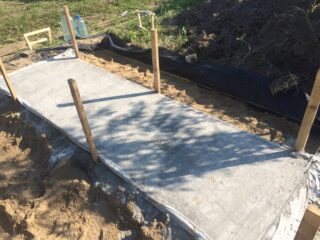
The laying depth is taken at the level of 30 - 50 cm, depending on the characteristics of the soil. The bottom of the pit is covered with sand and crushed stone (total layer 20 cm), reinforcement must be used.
Types of foundations for a barbecue oven:
- columnar is built for small structures, it is made of bricks, concrete prefabricated blocks;
- reinforced concrete tape is the most common; it is poured along the perimeter of the stove;
- a monolithic slab is the most acceptable option in terms of reliability.
The strip and slab base is made so that on each side it protrudes 10 cm from the contour of the walls.
Preparatory work includes cleaning the construction site, cutting off the fertile layer to a depth of 15 - 20 cm. A pit is laid out on the ground, the axes of the structure are set using stakes and twine. For stakes, pieces of reinforcement are taken or wooden ones are prepared. The latter are sharpened at one end for better entry into the ground.
Choosing a brand of cement
Cement binds the components of the concrete mixture, the quality of concrete depends on the choice of its brand: compressive strength, bending. The designation begins with the letter M. The number following the letter indicates the tensile strength in kilograms that can withstand 1 cm². The higher the value, the more heavy loads the base will withstand.
For the foundation for a barbecue oven, they take a brand of cement M 350 or M 400. The material is purchased from trusted suppliers, since the brand can be overstated. The ratio of the components of the mixture depends on the category of cement.
Concrete preparation and pouring
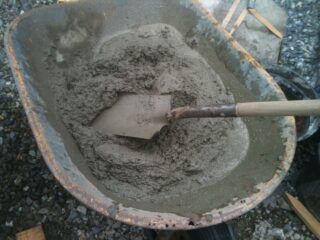
For the foundation of the furnace, a concrete mixture is prepared at a concentration of 1: 3: 5 (cement M400, sand, crushed stone, respectively). Use a concrete mixer or mix by hand.
After the device of sand and crushed stone bedding, a layer of roofing material is laid. Formwork is installed from boards or shields, it is bursting with bars from the outside. A metal mesh is made from reinforcement with a diameter of 8 - 10 mm. It is installed on pads so that there is at least 4 cm to the edge of the formwork.
Concrete is poured continuously, if they take a break, leave an inclined seam. After pouring, the concrete is covered with polyethylene.
Laying a simple barbecue oven with a firebox
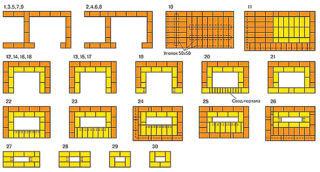
Masonry orders are used, in which the layout of the bricks in each subsequent row is indicated. Smoke should be fed into the chimney after moving along special passages. If the inner ducts are folded incorrectly, there will be no draft or smoke will come out of the combustion chamber.
Usually the masonry is made with a thickness of ½ - 1 brick, the stones are placed with bandaging of horizontal and vertical masonry joints. Metal grates, doors are installed in the masonry with an interval of 0.5 - 0.7 cm in order to take into account the difference in the expansion of iron and brick when heated.
A clay-sand solution is used, which is prepared at a concentration of 1: 2 (clay, sand, respectively). Lime dough is sometimes added.
Barbecue rules
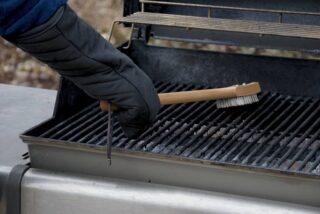
Deciduous trunks are used for kindling, for example, oak, birch, mulberry, cherry, apple tree. Coniferous firewood is not burned, since they release resinous substances when burned.
For heating efficiency, ash is removed in the lower part so that it does not block air access, and new logs are placed in 20-25 minutes. During cooking, they do not leave the brazier, regularly turn the food on the wire rack so that it does not burn out.
Maintaining a brick barbecue involves regular cleaning. If the unit is not used, burned-out residues and cooled raw materials are removed. Be sure to clean the grate, remove the remaining fat and adhering food pieces. For this, there are abrasive brushes and cleaning fluids.








